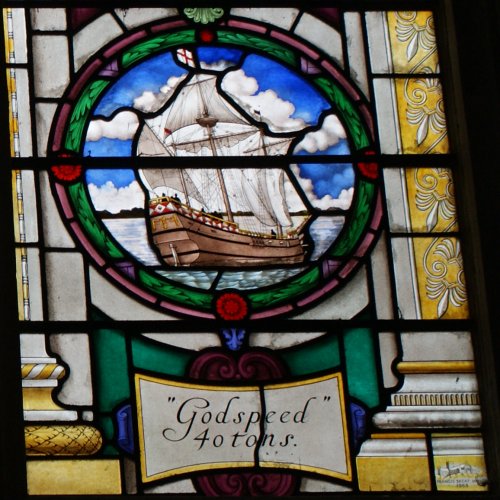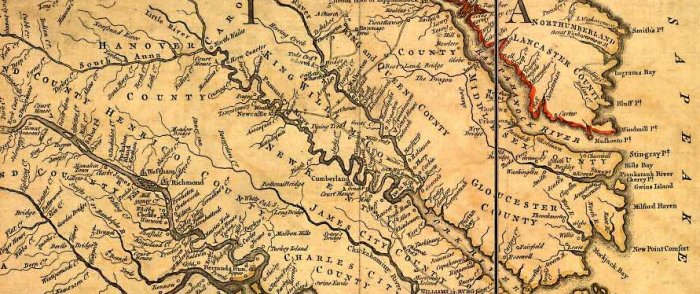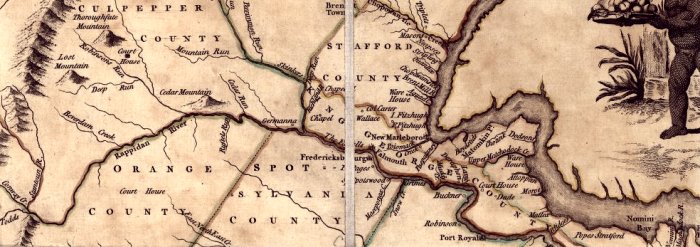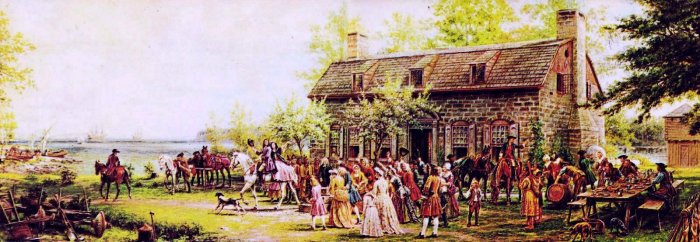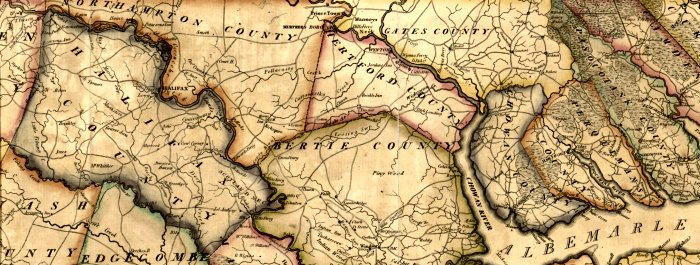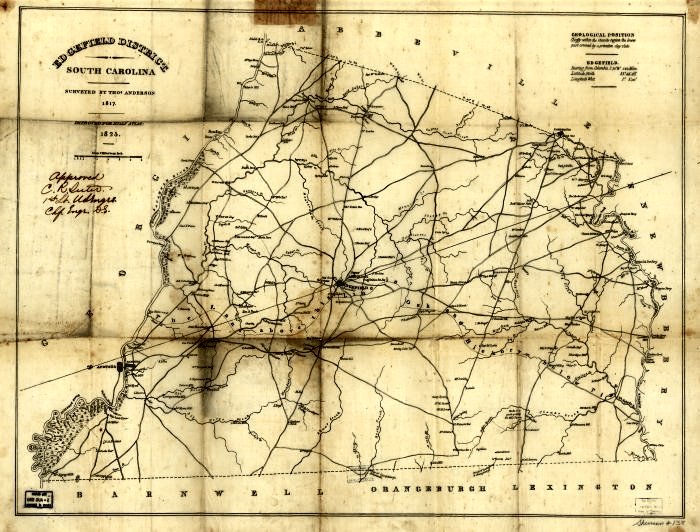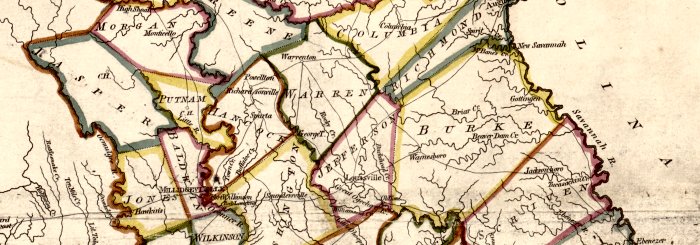|
The Cox Family By Steven R. Butler, Ph.D. Cox Family Introduction | James Cox | William Cox | Cary Cox, Sr. | Asa Cox | Isabella Cox Hill The Butler and Cox families are related by virtue of the marriage of my grandfather Herman H. Butler to Alice May Tate, who was a daughter of Isaac H. Tate, who was a son of Harrison Tate and his wife Mariah Hill, who was a daughter of Isaac Hill and his wife Isabella Cox, who was a daughter of Asa Cox of Harris County, Georgia. "Our" branch of the Cox (also spelled Coxe, Cocks, Cockes, Cock, and Cocke) family reportedly has a long history in America, which may have begun during the very first century of English colonization on this continent. Although no documentary evidence was put forth to support it, a book published in 1913 by the Rev. Henry Miller Cox, The Cox Family in America, suggests that our branch stems from a man named "Thomas Coxe-said to be of Welsh ancestry," whose "forebears…resisted the authority of the English King," resulting in the confiscation of their lands. Thomas Coxe, the Reverend Cox states further, "settled at Jamestown [Virginia] about 1614" and became the owner of "a fine estate on the James River," where he "reared ten sons" whose names were Ichabod, Sampson, Jesse, Asa, Cary, Rowan, Willis, Oran, Bartley, and George. There is no mention of his wife.1 In respect to this alleged forebear, the Reverend Cox adds only that Thomas Coxe purchased "two African negroes, man and wife," from a "Dutch trader, coming up the James River" and that this nearly led to tragedy when:
Skipping ahead "about a hundred years," the Reverend Cox goes on to say that "one branch of the family removed to North Carolina, and thence, after another century, or so, to Georgia."3 While all this is more or less true, the Reverend was off by a number of years in his calculations. As will be seen in the individual biographical sketches that follow, the move to North Carolina occurred during the mid-eighteenth century, with the move to Georgia (following a brief sojourn in South Carolina) coming less than a half-century later. The only other individuals named in this section of the book are Asa Cox, my fourth great-grandfather, whose place of abode is correctly identified as Harris County, Georgia, and his brother Ichabod Cox of Stewart County, Georgia. It is remarked that Ichabod was "a grandfather of Gen. John B. Gordon." This information, the Reverend Cox informs his reader, came to him from J. A. Cox of Tennessee, a grandson of Asa, who boasted that his grandfather lived to the ripe old age of 95 years.4 This section of the Reverend Cox's book concludes with the notation "No case of tuberculosis is recorded" in this particular branch of the family and that the following physical characteristics are generally seen in its members: "eyes, gray or brown,-sometimes blue or black; many are tall-six feet or more; some low in stature; hair, black, brown, and sometimes auburn to red."5 Although it is entirely possible that the Thomas Coxe who arrived in Virginia in 1614 was our ancestor, he may not be our only prospect. Sometime between 1998 and 2008 a modern-day researcher, Sherry S. Finchum of Jefferson City, Tennessee, posted information on the Internet about a man named William Coxe, who also settled at Jamestown, Virginia during its first decade and from whom we might also be descended. Acknowledging both printed and digitized sources, as well as her private correspondents, Ms. Finchum's online compilation provides a fairly detailed view of this individual. From one book, Adventurers of Purse and Person, she quotes the following:
A series of volumes entitled Cavaliers and Pioneers, published by the Virginia State Library, also mentions William Coxe, both supporting and supplementing the information contained in the above extract. It should be noted however, that Ms. Finchum makes no effort to connect "our" Coxes to William Coxe and as yet, no evidence has been found to confirm it. The Alabama Suranme Files (Expanded), which can be viewed on Ancestry.com provides us with another source the for Cox family, but one, I think, that is flawed. According to information found on Image 321, "The Hill Line & Cox," our earliest Cox ancestor in America was Thomas Coxe, as claimed by the above-mentioned Rev. Henry Miller Cox. Uhlike Reverend Cox, however, the Alabama Suranme Files shows a line of descent from Thomas Coxe to George Cox, to Moses Cox, who is supposed to be the father of "our" Williiam Cox (see below). However, I don't believe the first three men in that line are our ancestors. The most useful, and most likely correct, information I have found regarding our Cox ancestors was compiled sometime before 1977 by the late Helen Robinson Graves, whose extensive research brought to light a great many informative primary documents (although none that connect us to either the previously-named Thomas or William Coxe). Thankfully, the result of Ms. Graves' research has been posted on the Internet by generous relatives, where it is freely available to anyone wanting to make personal use of it. I for one am grateful because it has saved me an enormous amount of time and effort. As a family history researcher of long standing, I know from my own experience how difficult and time consuming it was, before the advent of the Internet, to locate the sort of material that Ms. Graves uncovered (and how often it still is very difficult and time consuming, since not everything can be located online just yet). In any case, thanks to Ms. Graves, and also to my distant cousin, Tynelle S. Jordan of Katy, Texas, who first brought the connection between the Hill and Cox families to my attention in 2005, we now know much more about some of our earliest ancestors than previously. James Cox Our earliest identifiable ancestor in this line is James Cox, although our knowledge of him is limited largely to that which is preserved in the public record. According to Helen Robinson Graves, he was born in either England or Wales. Unfortunately, she cites no actual evidence of it. Ms. Graves also states, again with no supporting evidence, that James Cox was married to his wife Elizabeth (whose maiden name has been lost to history) in the year 1698, presumably in Virginia. The earliest document presented by Ms. Graves pertaining to James Cox is his will, which she located in the records of Orange County, Virginia. From this instrument, made in 1738, we know the names of Cox's wife and his children, whose birth years have been posted on the Internet by Joel Robinson, a grand-nephew of Ms. Graves, as follows: William, born 1700; Naomi, born 1702; James, born 1704; son Frances [sic], born 1706; and John, born 1708. Unfortunately, Mr. Robinson provides no evidence for these dates and he also states that William Cox was born in Orange County, which is impossible owing to the fact that Orange County was not formed until 1734. It is interesting to note too that in his will, James Cox states that James Jr., Frances (or Francis as it should be spelled), and Naomi are not of lawful age, which was traditionally twenty-one. This means of course that none of these three children could have been born before 1717. This demonstrates that information received from other researchers needs to be "taken with a grain of salt," unless or until it can be verified by documentation. Although Ms. Graves was apparently very thorough in her search for genealogical data, it appears that she overlooked some early land records, which are preserved in the Library of Virginia and are thankfully now available on the Internet in digital form. The earliest of these is a land patent issued in the name of King George II to James Cox on 13 November 1721 by the provincial governor, Alexander Spotswood. Whether this particular James Cox is our James Cox, or not, I cannot say with certainty but it is certainly possible. In any case, in consideration of payment of the sum of 15 shillings, Cox received a patent or title to 120 acres of land "on Pages Head line on the upper side of a branch or Pampertike Creek in St. John's Parish," King William County (named for King William of Orange).7
Nearly ten years later, on 25 August 1731, Spotswood's successor, William Gooch, issued another patent to James Cox, also in the name of King George II, in which Cox received title to 137 acres of land in St. Margaret's Parish, King William County, "for Divers Good favours & Considerations but more Especially For and in Consideration of The Sum of Fifteen Shillings of Good and Lawful money." This particular parcel or tract was located "on Mangahick Swamp in Mr. Fleming's Line." On that very same day, for the sum of 20 shillings, James Cox received an additional patent for 187 acres in the same parish and county, "beginning on Mangahick Creek in Col. Byrd's line."8 (This may be, and probably is, a reference to the very wealthy and illustrious Virginia planter William Byrd II.) In 1734 Orange County (also named for King William of Orange) was formed from Spotsylvania County (named for Governor Alexander Spotswood), which in turn had been formed in 1721 from Essex, King and Queen, and King William counties. On 10 January 1736, Governor Gooch issued a patent to James Cox for 200 acres of land in this new county "amongst the heads of the branches of Terry's run adjoining Henry Berry and Edward Hay[ley]." The cost was "Twenty Shillings of good and lawful Money for our use Paid to the Receiver General of our Revenues in this our Colony and Dominion of Virginia."9 On 5 June that same year, Cox purchased a further 400 acres, also adjoining the property of Edward Hayley (or Halley). For this second tract he paid 40 shillings. Both sales were conditional, however, upon Cox "improving," within three years after the date of the patent, a minimum of three out of each fifty acres and paying a rent of one shilling each year "upon the Feast of Saint Michael the Arch Angel."10
Although I have no way to prove it, I feel confident that the James Cox who purchased land in King William County in the 1720s is the same man who bought property in Orange County in the 1730s. If so, the question arises: What became of Cox's land holdings in King William County? Unfortunately, that question cannot be answered because in 1885 a fire destroyed most of King William County's land records for the colonial period. It is reasonable to assume, however, that he simply sold it before, or shortly after, removing himself and his family to Orange County. On 12 December 1738, James Cox was stricken with a life-threatening illness, prompting him to make out a will, which can be found on file in Orange County. It contains a treasure trove of information about both him and his family.11 First of all, Cox's will makes it evident that he was very well off, at least in terms of land. Altogether, he bequeathed in excess of 2,000 acres, which is slightly more than three square miles! First mentioned in the will is son John, who was to receive 200 acres, along with 25 more that Cox had purchased from Edward Hayley. Son Frances [sic] was also to receive 200 acres, "it being part of a tract of five hundred and eighty acres not yet patent[ed]." The remainder of this particular tract was willed to James (200 acres) and Naomi (180 acres). Sons William and James were each to receive 150 acres in neighboring Hanover County.12 Just why James was clearly being favored more than the other children is unknown. Cox also left 300 acres to one Henry Isbell, "where the said Henry Isbell now lives," and 120 acres to a man named John Evans, it being the property on which Evans "now dwells." Another individual, Joseph Holder, was bequeathed 110 acres, it being "the remainder part of the tract of Henry Isbell and Joseph Evans."13 Cox's relationship to these three men is unstated in the will. They could be relatives, or friends, or perhaps even employees. Cox's brother William also received a bequest-"400 acres of land that said William Cox now lives on" subject to the payment of £9 "within one month" and some further sums that were due by 1 January 1739. If his brother failed to meet these conditions, Cox directed that the land be sold.14 Finally, to his "beloved" wife Elizabeth he left "his Negro man" and "all…other moveable estate, " appointing her, his son William, and a gentleman neighbor named William Waller to be "the only and sole executors" of his estate.15 To the modern eye, the fact that James Cox's will was probated on 22 February 1738 might seem to be a mistake. After all, how could a will made out in December 1738 be probated in February 1738, apparently ten months earlier? The answer is that it was not, since of course such a thing is impossible. Here's an explanation: In 1738, the English (and by extension the colonists in America), used the Julian calendar, whereby each New Year began on March 25, not January 1. In September 1752 the English (as well as the American colonists) adopted the Gregorian calendar, which is the one in use in most of the world today. This new calendar not only established the beginning of each New Year as January 1, it also corrected a twelve-day error resulting from use of the previous calendar. Thus Wednesday, September 2, 1752 was immediately followed by Thursday, September 14, 1752. Today, American and British historians and genealogists often write dates prior to 1752 like this: 22 February 1738/39, or 22 February 1738 (OS). (OS is the abbreviation for "Old Style.") William Cox William Cox was a son (probably the oldest) of James Cox of Orange County, Virginia and his wife Elizabeth, whose maiden name is unknown. William was probably born in Virginia, although in which county we do not know. (It is also possible of course, that he was born somewhere in the British Isles.) Like his father before him, we really know nothing about William Cox that is not in the public record. There are a number of land patent records on file for "William Cox" in the Library of Virginia but not all these pertain to our ancestor. What follows is a summation of those that do or probably do. Sometime between December and February 1738 (OS), James Cox died, leaving his son William 150 acres of land in Hanover County.16 A little more than a year later, on 12 March 1739/40, "William Cox, son of James Cox, dec'ed [deceased]" added to his land holdings by paying forty shillings for 400 acres "lying and being in the county of Hanover on both sides of Lynches River" and bounded on one side by the "line that divides the said county from Orange." As was the custom in those days, Governor William Gooch, under whose auspices the patent was issued in the name of King George II, required that three of every fifty acres be improved and that he (the Governor) should receive an annual fee of one shilling for every fifty acres.17 On 1 June 1741 William Cox received another patent from the governor, this time for 543 acres in Orange County, "in Consideration of the Importation of three Persons [almost certainly indentured servants] to dwell within this our Colony and Dominion of Virginia" and also "for and in Consideration of the sum of Forty Shillings of good and lawful money." The three "imported" persons named in the patent were: John Evans; George Coleman; and James Steavens.18 In 1743 William Cox increased his land holdings further by paying forty shillings for 850 acres of land "lying and being in the [adjacent] County of Louisa on both sides of Lynches River at the foot of the Great [Blue Ridge] Mountains." Governor William Gooch issued the patent for this property, containing the usual stipulations regarding improvements and annual fees, on 25 November.19 It seems likely that another patent, issued to one William Cox on 1 March 1743/44, for 380 acres of land in neighboring Goochland County, also pertains to our ancestor, owing to the proximity of this property to that which is described in the preceding paragraphs. The price again was forty shillings.20 In his will, which is dated 20 June 1751 William Cox identified himself as a resident of St. Thomas' Parish, Orange County, Virginia. It was probated in the circuit court of Orange County on 28 May 1752. The will provides evidence that William Cox was married to a woman named Martha, whose maiden name has been lost to history. It also reveals that he was the father of no fewer than four sons: William, Tyre, Care or Cary, and Toliver.21 Apparently, he had no daughters. Although through both inheritance and purchase, William Cox had once owned nearly 2,000 acres of land, by the time he died his holdings had been reduced by more than half. (Jn 1741, he sold a total of 1,060 acres.) The reason is unknown. In any case, Cox left each of his sons 100 acres of land. The remaining 300 acres of his estate was to be "loaned" to his wife until her own decease, at which time the land was to be divided among his sons.22 Cary Cox, Sr. According to Helen Robinson Graves, Cary Cox (Sr.) was born in 1736. On the Internet, Joel Robinson also cites this date but gives Halifax County, North Carolina as the place of his (Cox's) birth but of course this cannot be the case owing to the fact that Cox's parents were quite obviously residents of Orange County, Virginia in 1736. It is logical to assume, therefore, that both Cary and his three brothers were all born in Orange County, or possibly in one of the other counties (Hanover, Louisa, and Goochland) where his father once owned property.
Ms. Graves tells us further that Cary Cox (Sr.) was married in Virginia about 1761 (age 25) to Mary Horne, who was age 18, and also probably a native of Virginia. The following year, says Ms. Graves, Cary Cox (Sr.) "moved his family to Halifax County, North Carolina."
Graves states further that Cary Cox (Sr.) "and his oldest son William served in the N.C. Line in the Revolutionary War where Cary had a finger shot off." This information is supported by a deposition made by 84-year-old William Cox in Habersham County, Georgia, in November 1845, when he was filing a claim for a federal Revolutionary War pension. It is also supported by a statement that 76-year-old Asa Cox, another son of Cary, swore to in 1852, apparently in support of his brother's claim (although what's puzzling is that it was made four years after his brother died).23 Unfortunately, both William and Asa were so old at the time they made these statements that each man's recollection of events had become rather sketchy. All Asa, who was born in 1776, seemed certain about was that his father and brother had both served the Patriot cause, that his father had been wounded and came home (although he said nothing about the nature of the wound), and that his brother continued to fight "for liberty against the Tories and British…until peace was made." Nearly all that William could recall with any degree of certainty was that he served from 1776 to 1778 as a private in the Fifth North Carolina Regiment in the company of a Captain Caswell, that he did so as a substitute for another man (whose name he could not remember), and that he had not taken part in any significant battles or engagements.24 The two men's statements also provide evidence that Cary Cox (Sr.) did in fact move his family from Orange County, Virginia to Halifax County, North Carolina before the Revolutionary War began. His son, William Cox, also stated, in an 1845 interrogatory attached to his deposition, that he (William) remained in Halifax County until 1790 or until he reached the age of twenty-five (he seemed unsure), at which time he removed to South Carolina, where, according to Asa Cox, the rest of the family had already moved in 1788, taking up residence in Edgefield District, which was located on the boundary of Georgia and South Carolina. Asa also confirmed that William followed "about two or three years after this" and that he (William) moved to Habersham County, Georgia about 1822, "where he [William] remained until his death which occurred on the 21st day of March 1848."25 Further evidence that Cary Cox (Sr.) and his family resided in Edgefield County (or "District") South Carolina can be found in the first United States census, which was taken in 1790. It shows that the Cary Cox household had two free white males over the age of 16, three free white males under the age of 16, and 5 free white females. There were no slaves or "other persons." Asa's brother Toliver was a also a resident of Edgefield County in 1790. An Anabert or Anabet Cox is also listed as the head of a family of three people (one female and two males, one of each category), immediately below the name of Cary Cox.26
The names of all of Cary Cox's children are as follows: William; Clara or Clarissa (married a man whose last name was Southall); James; Asa; Jesse; Cary Jr; and Ichabod, who was reportedly a grandfather of Confederate General John B. Gordon. The Cary Cox family did not remain long in Edgefield County, South Carolina. Thanks to some church records uncovered by Ms. Graves, we know that they were living in Warren County, Georgia by 1795. Ms. Graves also informs us that Cary Cox and his wife eventually settled in Putnam County, Georgia (in 1807), where Cary died 24 March 1814 and his wife Mary died on 2 September 1823. They are reportedly buried in the "Old Cox Cemetery," near the community of Eatonton, which is now located in the midst of the Oconee National Forest. Asa Cox Asa Cox, a farmer by occupation, was a son of Cary Cox (Sr.) and his wife Mary Horne. He was reportedly born circa 1773-1776 in Halifax, North Carolina around the time his father and older brother William were serving in the Continental Army during the Revolutionary War. In 1788, the Cary Cox family reportedly moved to Edgefield County, South Carolina, where they remained until about 1795, when they are supposed to have removed to Warren County, Georgia. It is believed that about 1807 Asa's parents went to live in Putnam County, Georgia with his (Asa's) brother Cary Jr. In 1793 Asa Cox was reportedly married to Mildred Mariah Rountree in either Union County, South Carolina or Union County, Georgia (South Carolina seems more likely). They had at least ten children:
It is believed that the first six children (Cary through William) were born in Warren County, Georgia, where, according to one researcher, Asa built a log cabin to house his family. It is further reported that Warren County deed records confirm that Asa Cox purchased land on 10 July 1798. (Note: One researcher also claims that Asa Cox was a "fortunate drawer" in the 1792 Georgia Land Lottery but this is impossible due to the fact that the first of eight State of Georgia land lotteries was not held until 1805.) The remaining four Cox children were reportedly born in Jones County, Georgia. If so, we can be sure that the family removed to Jones County, which is located south of and adjacent to Putnam County, sometime between 1808 and 1812.
Unfortunately, both the 1800 and 1810 federal census schedules for Georgia were destroyed when the British army burned Washington, D.C. during the War of 1812, a conflict in which Asa Cox may have participated as a corporal in Captain Brodnax's Detachment of the Georgia Militia.27 However, since there were two other men named Asa Cox residing in Georgia around the same time, we cannot be sure if the War of 1812 veterans is "our" Asa Cox. Another researcher alleges that Asa Cox took part in the Creek Indian War of 1826 but I have found no record of it. Presently, our earliest known public record of Asa Cox is dated 1816, when he sold 130 acres (lot #80 in land district 13) to one James Huff. The sale is recorded in the Jones County deed records, Book 1J, page 311. The "J" indicates that the property was actually located in adjoining Jasper County.28 Asa Cox was also enumerated in the 1820 federal census for Jones County, Georgia. Unfortunately, the form is very difficult to read, making it impossible to determine the actual number of people who resided in this household or their ages.29 During the Cox family's sojourn in Jones County, the oldest five of Asa and Mildred's ten children were married and began families of their own. The first of the these marriages, almost all of which took place in Jones County, was that of eldest daughter, nineteen-year-old Matilda, who wed William Griffin on 12 November 1818. Next was eldest son Cary, who married Sarah Weeks on 7 July 1820. Then, on 14 August 1821, son James married Mary Curson. A little more than a year later, on 21 November 1822, twenty-one-year-old Isabella married Isaac Hill. A little more than a month later, on 22 December 1822, James Cox married Elizabeth Manley.30 Finally, on 26 February 1829, daughter Mariah married Hiram Dorman in Fayette County, Georgia.31 The 1830 federal census for Jones County, Georgia is more legible than the previous one. It confirms that the Asa Cox household consisted of one free white male age 5 to 9 (born 1821-1825; identity uncertain since the age does not match any known children), one free white male age 10 to 14 (born 1816-1820; this is probably Jesse since he had not had his birthday yet), one free white male age 40 to 49 (Asa, presumably, although he was almost certainly over fifty at this time), one free white female age 10 to 14 (born 1816-1820; this must be daughter Mary), one free white female 30 to 39 (Asa's wife, who like her husband was actually older), and two slaves.32 Lists of letters awaiting pick-up at the post office in Hamilton, Georgia, published in the Columbus (Georgia) Enquirer, provide evidence that the Asa Cox family had removed to Harris County, Georgia by 1833.33 There is further evidence in the form of the 1840 federal census for Harris County, which shows Asa Cox with a household that consisted of one free white male age 15 to 20, one free white male 60 to 70 (Asa), one free white female age 15 to 20, one free white female age 60 to 70 (Mildred). A this time, he owned no slaves.34 Curiously, the ages of the young man and the young woman in the household at this time do not match the ages of any of Asa and Mildred Cox's known children. By 1840 there should only have been seven-year-old Thomas still living at home.
The 1850 federal census, the first to name all members of the household, finds Asa Cox still living in Harris County, Georgia, listing only him, age 74, and his wife, age 72, who is misidentified as "Mary" instead Mariah. The census confirms Asa's birthplace, North Carolina, his wife's (South Carolina), and identifies him as a farmer with $1,300 worth of real estate.35 The 1850 slave schedule also identifies him as the owner of twelve slaves: one mulatto female, age sixty-five; one black male, age thirty-six; one black female, age twenty-eight; one black female, age forty-five; one black female, age twenty-one; one black male, age fourteen; one black male, age twelve; one black male, age ten; one black male, age eight; one black male, age nine; one black male, age two; and one black male, age seven.36 Asa's wife Mariah died on15 November 1854 in Harris County, Georgia.37 Her place of burial is presently unknown. The 1860 federal census for Harris County found Asa Cox, age eighty-four, living in or near Valley Plains, Harris County, Georgia, with his widowed daughter Isabella Hill, age fifty-nine; an overseer named D. Johnny, age twenty-three, and the overseer's wife, apparently, named Jennett, age nineteen, another young man, age twenty-two, named Andrew Johnny (presumably the overseer's brother), and a five-month-old baby girl identified only by her initials, "F. J." This census reveals too that Asa Cox' owned $1,500 worth of real estate and $11,000 worth of personal property. His daughter Isabella also owned personal property, to the value of $2,560.38 The 1850 slave schedule shows that Asa's personal property consisted largely, or entirely, of his twelve slaves: one black female, age seventy; one black female, age forty; one black male, age thirty; one black male, age twenty-three; one black male, age twenty-one; one black male, age eighteen; one black female, age fourteen; one black female, age twelve; one black male, age eight; one black female, age five; and one black female, three months old. The information available about these slaves indicate that these are not all the same slaves that he owned in 1850, and that consequently, he must have both bought and sold slaves during the previous decade. Asa's adult daughter Isabella owned three slaves of her own: one black female, age thirty-five; one black female, age ten; and one black female, age two.39 In 1856 Asa Cox wrote a will, which has been preserved in the records of Harris County, Georgia, in the county courthouse. It names all his children and directs that his estate be sold upon his death and divided equally among them, except that Isabella was to receive one hundred dollars more than the others. He also identifies one of his slaves, a boy named Moses, who was to be given to his son Thomas Cox, and then living in Mississippi, with the proviso that the boy not be sold or given away or used to pay any debts. Cox's sons-in-law were also named, and sons James and Jesse were appointed executors of the will.40 A codicil to the will, made in 1857, provided that daughter Isabella would receive a further $100 upon her father's death, "making in all, two hundred dollars." The old man also gave "to the said Isabella Hill" his "buggy and also thirty dollars annually," making it perfectly why Isabella was being more favored than the others: "Because she, the said Isabella, has…taken care of me and my interest while I have been unable to take care of myself when all of my other children have been taking care of their own interest."41 Asa Cox reportedly died during the Civil War, on 7 December 1863, at the advanced age of eighty-seven. Although the location of his gravesite has apparently been lost to history, he was almost certainly interred somewhere in the vicinity of his farm or plantation in Harris County, Georgia. Isabella Cox Hill Isabella Cox Hill outlived her father Asa by two decades. The 1870 census shows her at age sixty-eight, living with the family of her widowed daughter Camilla Stephens, in or near the Harris County seat of Hamilton.42 In 1880 Isabella and her daughter and family were living in Carroll County, Georgia.43 On 9 October 1883, Isabella Cox, at the age of nearly eighty, Isabella Cox passed away and was buried at the Buchanan City Cemetery in Buchanan, Haralson County, Georgia. Her daughter Camilla died in 1910 and was buried in the same cemetery.44 NOTES TBA="To Be Added" 1Rev. Henry Miller Cox, A.M., The Cox Family in America (New York: n. p., 1912), 62. 2Ibid. 3Ibid. 4Ibid. 5Ibid. 6Annie Lash Jester and Martha Woodroof Hiden, Adventurers of Purse and Person, Virginia, 1607-1625 (Princeton, New Jersey: 1956), 211-16. 7TBA 8TBA 9TBA 10TBA 11Will of James Cox, Will Book I, page 72, Orange County, Virginia. 12TBA 13TBA 14TBA 15TBA 16Will of James Cox, Will Book I, page 72, Orange County, Virginia. 17Library of Virginia, Virginia Land Office Patents, No. 18 (1738-1738), pp.542-3 (Reel 16) 18Library of Virginia, Virginia Land Office Patents, No. 19 (1739-1741), pp.943-4 (Reel 17) 19Library of Virginia, Virginia Land Office Patents, No. 21 (1742-1743), vol. 1 and 2 pp.1-674, pp.638-43 (Reel 19) 20Library of Virginia, Virginia Land Office Patents, No. 22 (1743-1745), vol. 1 and 2 pp.1-631, pp.10-11 (Reel 20) 21Will of William Cox, Will Book 2, pp.166-7, Orange County, Virginia. 22Ibid. 23TBA24TBA 25TBA 26TBA 27National Archives and Records Administration, Washington, D.C., War of 1812 Service Records. 28TBA 29TBA 30All but the marriage of Cary Chappell Cox and Sarah Weeks are recorded in Jones County Marriage Book, A, 1811-1828, Jones County Courthouse, Gray, Georgia (Cox-Griffin, p. 83; Cox-Curson, p. 158; Cox-Hill, p. 212). 31Fayette County Courthouse, Fayetteville, Georgia, Marriage Book A, 81. 32TBA 33TBA 34TBA 35TBA 36TBA 37This information was obtained from another researcher who gave no source for it. 38TBA 39TBA 40TBA 41Will of Asa Cox, Harris County Courthouse, Hamilton, Georgia, Will Book 2, 137-178. 42TBA 43TBA 44Grave marker, Buchanan City Cemetery, Haralson County, Georgia.
This website copyright © 1996-2013 by Steven R. Butler, Ph.D. All rights reserved. |


